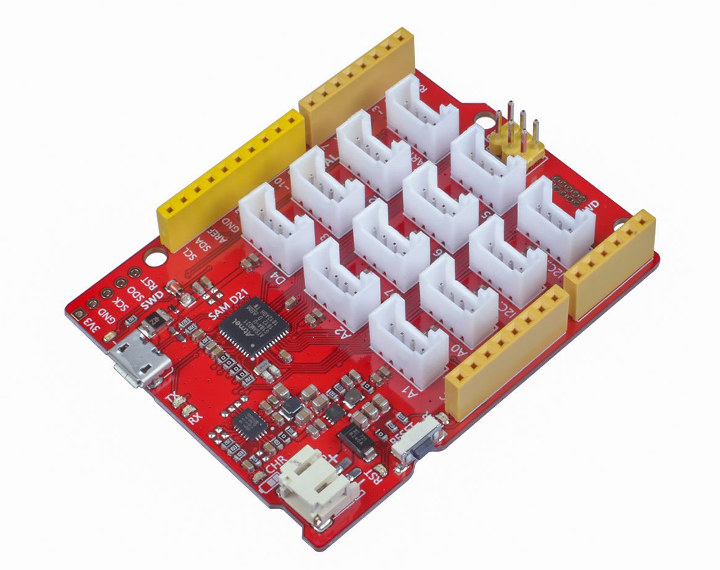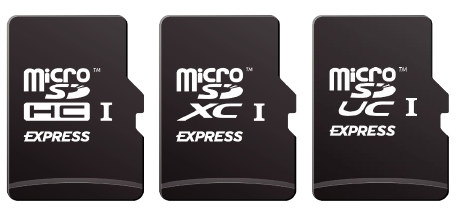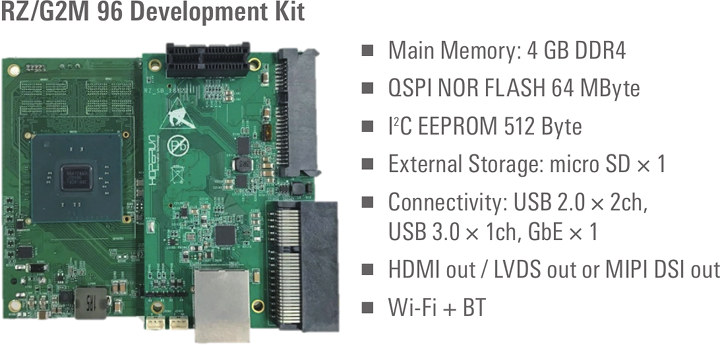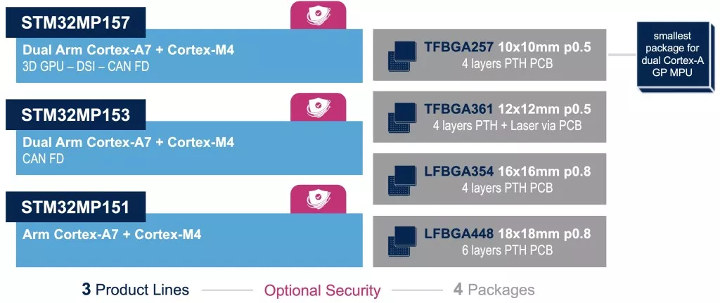Grove modules are cool little add-on boards that connect through 4-pin header using UART, I2C, analog or digital I/Os, and usually you’d need to buy a HAT or shield to connect them to respectively Raspberry Pi or Arduino board. But Seeed Studio has come up with a small Arduino compatible board based on Microchip SAMD21 microcontroller called Seeeduino Lotus Cortex-M0+ that may be the cheapest “Grove” solution around as it sells for just $9.90. Seeeduino Lotus Cortex-M0+ specifications: MCU – Microchip Atmel SAMD21 Arm Cortex-M0+ microcontroller at 48MHz with 256KB Flash and 32KB SRAM as found in Arduino Zero. USB – 1x micro USB port for power and programming Expansion 12x on-board Grove connectors (6x Digital, 3x Analog, 1x UART and 2x I2C) Arduino UNO headers 14x Digital I/O Pins (10 PWM outputs) 6x Analog Inputs I/O pins are 3.3V, do not input more than 3.3V, otherwise the CPU may […]
TI AM5729 Powered BeagleBone-AI Comes with TI C66x DSP and EVE Cores
Launched in 2013, BeagleBone Black is still one of the most popular hobbyist board thanks to its many I/Os, software support, and affordable price with being the cheapest board around those days. But it looks like we’ll soon have a new version that allows to experiment with artificial intelligence workloads. BeagleBone-AI is powered by Texas Instruments AM5729 SoC equipped with TI C66x digital-signal-processor (DSP) cores and embedded-vision-engine (EVE) cores supported through a TIDL (Texas Instruments Deep Learning) machine learning OpenCL API. BeagleBone-AI preliminary specifications: SoC – TI AM5729 dual core Cortex-A15 processor featuring 4 PRUs, Dual core C66x DSP, and 4 EVEs System Memory – 1GB RAM Storage – 16GB on-board eMMC flash with high-speed interface Networking – Gigabit Ethernet and high-speed WiFi SB – 1x USB type-C for power and superspeed dual-role controller, 1x USB type-A host Expansion – BeagleBone Black (BBB) compatible headers Dimensions – 86.4 x 53.4 […]
Snapdragon 8cx 5G Compute Platform Targets 5G always on, always connected PCs
Qualcomm announced Snapdragon 8cx processor for so-called always on, always connected mobile PCs in December 2018. The processor comes with eight Qualcomm Kryo 495 core, an Adreno 680 GPU with a 128-bit memory interface, NVME SSD, UFS 3.0 support, as well as a Snapdragon X24 4G LTE modem among other features. But the launch 5G cellular connectivity will start to (slowly) take off this year, so the company also revealed plans for Snapdragon 8cx 5G compute platform that brings the same processing power as 8cx processor but with an extra Snapdragon X55 5G modem. The company did not provide that many details about Snapdragon 8cx 5G in the press release, but we already know Snapdragon 8cx specifications as well as the key features of Snapdragon X55 2nd generation 5G modem, so we should already have a good idea about the platform. Qualcomm highlights the 7nm manufacturing process, multi-day battery life, and multi-gigabit […]
microSD Express Cards to Deliver SSD Performance
Last Summer the SD association released SD 7.0 specification with two key new features: SD Express adding PCIe and NVMe interfaces to the legacy SD card interface for transfer rates of up to 985MB/s, and SDUC (SD Ultra Capacity) card allowing capacities of up to 128 TB. This all looks great, but while the latter was available for both micro SD cards and full size SD cards, microSD cards could not benefit from the new high speed interfaces part of SD Express specification. SD 7.1 specification fixes that, as the SD association has now added microSD Express card which will also be able to reach up to 985MB/s (in theory) thanks to PCIe/NVMe interfaces, so we’ll be able to get sort of “removable SSDs” for smartphone and other devices that compatible with SD Express. As illustrated above microSD Express cards will be available in various capacities as microSDHC Express, microSDXC […]
Renesas RZ/G2 64-Bit MPUs Target Industrial Applications Leveraging SLTS Linux
Renesas RZ/G1 Cortex-A15/A7 processor series was introduced in 2016 targeting industrial human machine interface, and RZ/G1M was one the the first processors supported by the industrial-grade CIP Super Long-Term Support (SLTS) Linux kernel – as part of Renesas RZ/G Linux Platform – with commitment of over 10 years of support. The company has now launched a 64-bit version of the industrial processors with Renesas RZ/G2 family featuring up to eight Cortex-A53/A57 cores and supported by RZ/G Linux Platform for long term Linux support. Renesas RZ/G2 family is now comprised of four SKUs with the following key features and specifications. RZ/G2 Series RZ/G2E RZ/G2N RZ/G2M RZ/G2H Economical Mid-Range (Pin Compatible) Highest Performance CPU (64-bit ARMv8A) 2x Cortex-A53 @ 1.2GHz L1, L2 Parity/ECC 2x Cortex-A57 @ 1.5GHz L1, L2 Parity/ECC 2x Cortex-A57 @ 1.5GHz 4x Cortex-A53 @ 1.2GHz L1, L2 Parity/ECC 4x Cortex-A57 @ 1.5GHz 4x Cortex-A53 @ 1.2GHz L1, L2 Parity/ECC […]
$100 Reolink Argus 2 is a Wire-Free IP Camera with Optional Solar Panel
This morning I had a look at battery-powered IP cameras since they avoid the hassle of wiring power and/or Ethernet around the house. I could remember I covered Immedia Blink IP camera with up to 2-year battery life back in 2014, and the company did very well since it got acquired by Amazon, and Blink IP security camera is now sold on Amazon US for $99.99 and up. It’s probably one of the best, if not the best options, for low-cost battery-powered cameras but the problem is that they only ship to a limited number of countries. Last year, there was a new entrant with Eufy Evercam outdoor IP camera with up to one year of battery life, but again it’s not easy to purchase from overseas, and the price starts at $279.99 for a single camera system. I also covered a solar and battery powered IP camera made by […]
Samsung Galaxy S10, S10+, S10e, S10 5G Launched with Snapdragon 855 or Exynos 9820 SoC
Samsung officially launched the long awaited Galaxy S10 smartphone yesterday sporting either a Qualcomm Snapdragon 855 or Samsung Exynos 9820 processor coupled with 8GB RAM, 128 to 512GB storage, and a 6.1″ display. There are actually four variants of Galaxy S10, with S10+ model coming with up to 12GB RAM, 1TB flash storage, and a 6.4″ display, S10e phone with a smaller 5.8″ display, as low as 6GB RAM, and 128 to 256GB flash storage, and S10 5G with a 5G modem, a larger 6.7″ display, 6 cameras, and a larger 4,500 mAh battery. Many consider Samsung Galaxy phones to be the reference when it comes to Android phones, so let’s have a look at the technical specifications and features to see if there’s anything really new beside more processing power, and memory. Galaxy S10, S10+, S10e, and S10 5G phones share many of the same specifications: SoC (one or […]
STMicro STM32MP1 Cortex A7/M4 MPU Supports Linux and Android
When Linux 4.17 was released last June, we discovered an interesting new STM32 part: STM32MP157C dual core Cortex-A7 processor. It was the first time I saw an STM32 IC not based on Arm Cortex-M microcontroller core, but we knew only very little details at the time. STMicro has now made it official, and introduced STM32MP1, the first STM32 MPU (Microprocessor Unit) that features one or two Arm Cortex-A7 cores running Linux, as well as an Arm Cortex-M4 real-time core that allows to re-use code from existing STM32 projects. STM32MP1 key features and specifications: Cores Single or Dual Cortex-A7 core(s) running at 650 MHz with 32-Kbyte L1 Instruction cache, 32-Kbyte L1 Data cache, 256-Kbyte Level 2 cache Cortex-M4 core running at 209 MHz with single-precision floating point unit (FPU), digital signal processor (DSP) instructions, and memory protection unit (MPU) GPU (STM32MP157 only) – Vivante 3D GPU with OpenGL ES 2.0 support; […]










